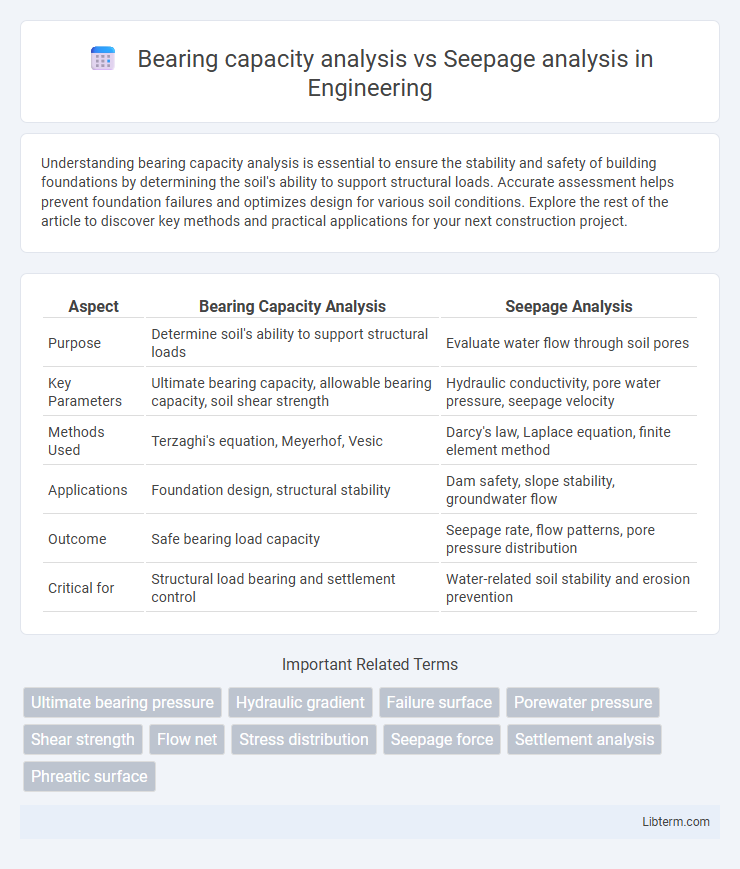Understanding bearing capacity analysis is essential to ensure the stability and safety of building foundations by determining the soil's ability to support structural loads. Accurate assessment helps prevent foundation failures and optimizes design for various soil conditions. Explore the rest of the article to discover key methods and practical applications for your next construction project.
Table of Comparison
| Aspect | Bearing Capacity Analysis | Seepage Analysis |
|---|---|---|
| Purpose | Determine soil's ability to support structural loads | Evaluate water flow through soil pores |
| Key Parameters | Ultimate bearing capacity, allowable bearing capacity, soil shear strength | Hydraulic conductivity, pore water pressure, seepage velocity |
| Methods Used | Terzaghi's equation, Meyerhof, Vesic | Darcy's law, Laplace equation, finite element method |
| Applications | Foundation design, structural stability | Dam safety, slope stability, groundwater flow |
| Outcome | Safe bearing load capacity | Seepage rate, flow patterns, pore pressure distribution |
| Critical for | Structural load bearing and settlement control | Water-related soil stability and erosion prevention |
Introduction to Bearing Capacity and Seepage Analysis
Bearing capacity analysis evaluates the maximum load soil can safely support without failure, essential for foundation design in geotechnical engineering. Seepage analysis assesses the movement of water through soil pores, critical for understanding groundwater flow and potential soil erosion or instability. Both analyses rely on soil properties but address different failure mechanisms to ensure structural and environmental safety.
Fundamental Concepts of Bearing Capacity
Bearing capacity analysis evaluates the soil's ability to support structural loads without experiencing shear failure, emphasizing parameters such as cohesion, internal friction angle, and soil density. Seepage analysis, in contrast, examines the movement of water through soil pores, focusing on hydraulic gradients, permeability, and pore water pressures. Understanding the fundamental bearing capacity concepts involves assessing the ultimate bearing capacity and factoring in soil stratification, foundation type, and load distribution to ensure safe and stable foundation design.
Key Principles of Seepage Analysis
Seepage analysis focuses on understanding the movement of water through soil layers and quantifying the hydraulic gradient, flow rate, and pore water pressure distribution using Darcy's law. It is essential for assessing potential issues like soil erosion, piping, and uplift pressures in geotechnical structures. Accurate seepage analysis ensures proper design of drainage systems, seepage control methods, and stability evaluations in earth dams and foundations.
Importance in Geotechnical Engineering
Bearing capacity analysis determines the maximum load soil can support without failure, crucial for foundation design and structural stability. Seepage analysis evaluates water movement within soil, essential for assessing soil strength, erosion potential, and groundwater control. Both analyses ensure safe and efficient geotechnical engineering by addressing load-bearing performance and hydraulic conditions.
Methods for Bearing Capacity Evaluation
Bearing capacity evaluation methods primarily include the Terzaghi, Meyerhof, and Vesic approaches, each using soil properties like cohesion, internal friction angle, and unit weight to calculate ultimate bearing capacity for shallow foundations. Limit equilibrium and finite element methods offer advanced analyses, integrating soil behavior under load and complex stress conditions to improve accuracy. Load test methods such as plate load tests complement analytical models by providing field data for bearing capacity verification.
Techniques for Seepage Analysis
Seepage analysis techniques primarily include numerical methods such as finite element and finite difference approaches, which simulate groundwater flow through soil to predict pore water pressures and seepage paths. Analytical methods, like Laplace's equation solutions and flow nets, offer simplified assessments of seepage in homogeneous soil layers but are limited by complex boundary conditions. Advanced software tools integrate these techniques with permeability data to optimize the design of effective drainage and cutoff systems in geotechnical engineering projects.
Factors Affecting Bearing Capacity
Factors affecting bearing capacity include soil type, density, moisture content, and load distribution, which determine the soil's ability to support structural loads without excessive settlement or failure. Bearing capacity analysis emphasizes geotechnical parameters such as shear strength, cohesion, and internal friction angle, while seepage analysis focuses on hydraulic gradients, permeability, and pore water pressure that influence soil stability due to water flow. Understanding soil stratigraphy and groundwater conditions is crucial in differentiating bearing capacity behavior from seepage-induced soil weakening.
Influential Parameters in Seepage Analysis
Seepage analysis primarily depends on hydraulic conductivity, soil permeability, and pore water pressure, which directly influence water flow through soil and affect stability. Unlike bearing capacity analysis, seepage focuses on parameters such as soil porosity, hydraulic gradient, and boundary conditions to predict seepage velocity and potential pore pressure buildup. Understanding these influential parameters is crucial for designing effective drainage and preventing soil erosion or failure due to seepage forces.
Comparative Assessment: Bearing Capacity vs Seepage
Bearing capacity analysis evaluates soil's ability to support structural loads without failure, focusing primarily on shear strength parameters and settlement predictions. Seepage analysis assesses groundwater flow through soil, emphasizing pore water pressure distribution and hydraulic gradients that influence soil stability and erosion potential. Comparing the two, bearing capacity analysis addresses load-bearing performance critical for foundation design, whereas seepage analysis targets fluid movement impacts essential for preventing soil weakening and structural failure due to water-induced forces.
Practical Applications and Case Studies
Bearing capacity analysis is crucial for designing foundations in construction projects, ensuring structures can safely support loads without excessive settlement or failure, with case studies highlighting its role in high-rise buildings and bridge piers. Seepage analysis plays a vital role in geotechnical engineering to prevent water flow-induced soil erosion, foundation instability, and dam seepage failures, as evidenced in case studies involving earth dams and levees. Both analyses are integrated in projects where soil-water interaction affects structural integrity, such as in retaining walls and embankments subjected to fluctuating groundwater levels.
Bearing capacity analysis Infographic

 libterm.com
libterm.com